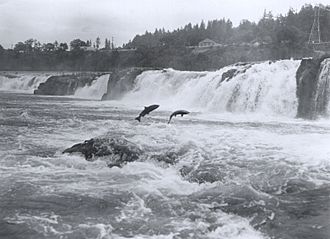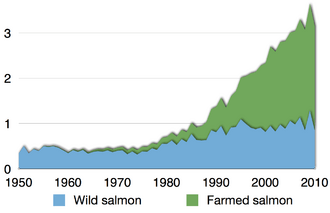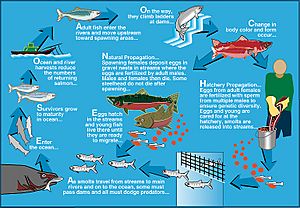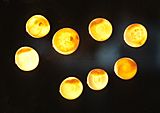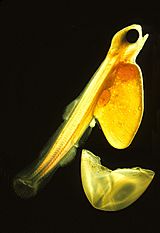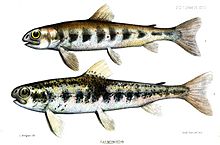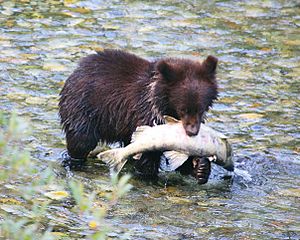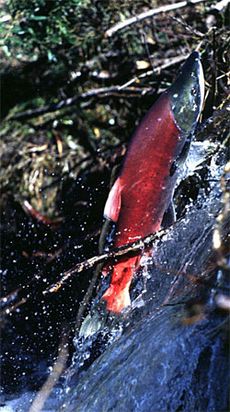Salmon facts for kids
Quick facts for kids Salmon |
|
|---|---|
 |
|
| Scientific classification | |
| Kingdom: | |
| Phylum: | |
| Order: | |
| Family: | |
| Subfamily: | |
Salmon are a type of fish that belong to the Salmonidae family. Other fish in this family include trout, char, grayling, and whitefish.
Salmon naturally live in rivers that flow into the North Atlantic Ocean (these are called Salmo salmon) and the Pacific Ocean (these are called Oncorhynchus salmon). People have also brought many salmon species to new places, like the Great Lakes in North America and Patagonia in South America. Salmon are also raised in farms in many parts of the world.
Most salmon are anadromous. This means they hatch in fresh water, then travel to the ocean to grow up. After a few years, they return to fresh water to lay their eggs. It's a common belief that salmon return to the exact spot where they were born to lay eggs. Studies show this is mostly true. However, some salmon might go to different rivers to spawn. Salmon have been around since the Neogene period, millions of years ago.
Contents
Types of Salmon
The word "salmon" comes from the Latin word salmo, which might mean "to leap." There are nine important types of salmon that people often catch. These are divided into two main groups, or genera.
The Salmo group includes the Atlantic salmon, which lives in the North Atlantic Ocean. This group also has many fish commonly called trout.
The Oncorhynchus group has eight species that naturally live only in the North Pacific Ocean. These are known as Pacific salmon. Some Pacific salmon, like Chinook salmon, have been introduced to places like New Zealand and Patagonia. Coho, freshwater sockeye, and Atlantic salmon have also been brought to Patagonia.
| Atlantic and Pacific Salmon Species | ||||||||||||
|---|---|---|---|---|---|---|---|---|---|---|---|---|
| Genus | Image | Common Name | Scientific Name | Max Length | Common Length | Max Weight | Max Age | Food Level | Status | |||
| Salmo (Atlantic salmon) |
 |
Atlantic salmon | Salmo salar Linnaeus, 1758 | 150 cm | 120 cm | 46.8 kg | 13 years | 4.4 | ||||
| Oncorhynchus (Pacific salmon) |
 |
Chinook salmon | Oncorhynchus tshawytscha (Walbaum, 1792) | 150 cm | 70 cm | 61.4 kg | 9 years | 4.4 | Not assessed | |||
 |
Chum salmon | Oncorhynchus keta (Walbaum, 1792) | 100 cm | 58 cm | 15.9 kg | 7 years | 3.5 | Not assessed | ||||
 |
Coho salmon | Oncorhynchus kisutch (Walbaum, 1792) | 108 cm | 71 cm | 15.2 kg | 5 years | 4.2 | Not assessed | ||||
 |
Masu salmon | Oncorhynchus masou (Brevoort, 1856) | 79 cm | cm | 10.0 kg | 3 years | 3.6 | Not assessed | ||||
 |
Pink salmon | Oncorhynchus gorbuscha (Walbaum, 1792) | 76 cm | 50 cm | 6.8 kg | 3 years | 4.2 | Not assessed | ||||
 |
Sockeye salmon | Oncorhynchus nerka (Walbaum, 1792) | 84 cm | 58 cm | 7.7 kg | 8 years | 3.7 | |||||
† Both the Salmo and Oncorhynchus groups also include many species called trout. Some other fish, like the Adriatic salmon (Salmo obtusirostris) and Black Sea salmon (Salmo labrax), are also called salmon. The steelhead is a type of rainbow trout that goes to sea, but it's not called a "salmon."
Some other fish are called "salmon" but are not true salmon from the Salmonidae family. For example, the Danube salmon is a large freshwater fish related to true salmon. But others, like the Australian salmon, are marine fish from a different group called Perciformes.
| Other Fish Called Salmon | ||||||||||
|---|---|---|---|---|---|---|---|---|---|---|
| Common Name | Scientific Name | Max Length | Common Length | Max Weight | Max Age | Food Level | Status | |||
| Australian salmon | Arripis trutta (Forster, 1801) | 89 cm | 47 cm | 9.4 kg | 26 years | 4.1 | Not assessed | |||
| Danube salmon | Hucho hucho (Linnaeus, 1758) | 150 cm | 70 cm | 52 kg | 15 years | 4.2 | ||||
| Hawaiian salmon | Elagatis bipinnulata (Quoy & Gaimard, 1825) | 180 cm | 90 cm | 46.2 kg | years | 3.6 | Not assessed | |||
| Indian salmon | Eleutheronema tetradactylum (Shaw, 1804) | 200 cm | 50 cm | 145 kg | years | 4.4 | Not assessed | |||
The oldest known salmon fossil, Eosalmo driftwoodensis, helps scientists understand how different salmon species developed. This fossil shows that Pacific and Atlantic salmon had not yet separated 40 million years ago. Both fossils and DNA studies suggest they split between 10 and 20 million years ago. This means salmon evolved long before the ice ages began.
Where Salmon Live
- Atlantic salmon (Salmo salar) lay their eggs in northern rivers on both sides of the Atlantic Ocean.
- Some Atlantic salmon, called landlocked salmon, live their whole lives in lakes. These include lakes in eastern North America and Northern Europe. They are the same species as Atlantic salmon, but they have learned to stay in fresh water even when they could go to the ocean.
- Chinook salmon (Oncorhynchus tshawytscha) are also known as king salmon or spring salmon. They are the biggest Pacific salmon, often weighing over 30 pounds (13.6 kg). Chinook salmon live as far north as the Mackenzie River in Canada and as far south as Central California.
- Chum salmon (Oncorhynchus keta) are also called dog salmon. This species lives in the widest area of all Pacific salmon. They are found from the Mackenzie River in Canada down to California, and from the Lena River in Siberia to Japan.
- Coho salmon (Oncorhynchus kisutch) are also known as silver salmon. They live along the coasts of Alaska and British Columbia, and as far south as Central California. They are sometimes found in the Mackenzie River too.
- Masu salmon or cherry salmon (Oncorhynchus masou) are found only in the western Pacific Ocean, in Japan, Korea, and Russia. A type of Masu salmon, called Taiwanese salmon, lives in a stream in central Taiwan.
- Pink salmon (Oncorhynchus gorbuscha), also called humpies, are found across the northern Pacific. They live from the Lena River in Siberia to Korea, and from the Mackenzie River in Canada to northern California. They are the smallest Pacific salmon, usually weighing about 3.5 to 4.0 pounds (1.6 to 1.8 kg).
- Sockeye salmon (Oncorhynchus nerka) are also known as red salmon. These salmon grow up in lakes. They are found from the Canadian Arctic to California, and from Siberia to Japan. Most adult Pacific salmon eat small fish, shrimp, and squid. But sockeye salmon eat tiny plankton by filtering them from the water. Kokanee salmon are sockeye salmon that live their whole lives in lakes.
- Danube salmon, or huchen (Hucho hucho), are the largest type of salmonid that lives only in fresh water.
Salmon Life Cycle and Reproduction
Salmon eggs are laid in freshwater streams, usually in colder northern areas. The eggs hatch into tiny fish called alevin or sac fry. These fry quickly grow into parr, which have stripes for camouflage. Parr stay in their home stream for six months to three years. Then they become smolts, which are shiny and silver, ready for the ocean. Only about 10% of salmon eggs survive to become smolts.
A smolt's body changes so it can live in salt water. Most salmon travel to the ocean to grow into adults. They spend some time in brackish water (a mix of fresh and salt water) to get used to the change.
Salmon live in the open ocean for one to five years, depending on the species. During this time, they slowly become ready to lay eggs. Adult salmon then return to their home streams to spawn. Atlantic salmon spend one to four years at sea. If a fish returns after only one year, it's called a grilse.
Before laying eggs, salmon change their appearance. They might grow a hump, develop sharp, dog-like teeth, or get a kype (a hooked jaw) if they are male. Their shiny silver color from the sea changes to a darker color. Salmon can travel incredible distances, sometimes hundreds of miles upstream against strong currents and waterfalls, just to reproduce. For example, Chinook and sockeye salmon from central Idaho travel over 900 miles (1,450 km) and climb nearly 7,000 feet (2,130 m) from the Pacific Ocean to spawn.
Salmon get weaker the longer they stay in fresh water. They get even weaker after they spawn. Pacific salmon species die within days or weeks after spawning. This is called semelparity. About 2 to 4% of Atlantic salmon females survive to spawn again. Even for species that can spawn more than once, many still die after laying eggs.
To lay her roe (eggs), the female salmon uses her tail to dig a shallow nest called a redd. A redd can hold about 5,000 eggs and cover 30 square feet (2.8 square meters). The eggs are usually orange to red. One or more male salmon join the female in the redd and release sperm over the eggs. The female then covers the eggs with gravel before moving on to make another redd. A female might make up to seven redds.
Each year, salmon have a period of fast growth, usually in summer, and slower growth in winter. This creates rings on their ear bones, similar to tree rings. Rings from freshwater growth are close together, while rings from sea growth are far apart. Spawning also leaves a mark as the fish use their body mass for eggs and sperm.
Young salmon live in freshwater streams and estuaries (where rivers meet the sea). They eat insects and small crustaceans. Older salmon mainly eat other fish. Salmon eggs need cool water and good water flow to get enough oxygen. Many young salmon die because of natural predators or changes to their habitat, like pollution, warm water, or low oxygen. Estuaries and their wetlands are important places for young salmon to grow before they go to the ocean. Wetlands help keep the water clean and provide places for salmon to feed and hide.
Salmon that are not caught or eaten by predators show very fast aging at the end of their lives. Their bodies quickly break down after spawning because of hormones released in their bodies.
Salmon in Nature
Bears and Salmon
In the Pacific Northwest and Alaska, salmon are a keystone species. This means they are very important for the ecosystem. They support animals like birds, bears, and otters. Salmon bodies bring nutrients from the ocean, like nitrogen and phosphorus, to the forest ecosystem.
Grizzly bears help the forest by catching salmon and carrying them into the woods. They leave behind nutrient-rich waste and half-eaten fish. Bears can leave up to half the salmon they catch on the forest floor. This provides a lot of nitrogen for the trees and plants near the rivers. Trees up to 500 meters (1,640 ft) from a stream where grizzlies fish have been found to have nitrogen from salmon.
Beavers and Salmon
Beavers also change their environment a lot by cutting down trees and building dams. Beaver ponds can be very important homes for young salmon. For example, in the Columbia River Basin, when beavers were removed in the 1800s, the number of salmon dropped sharply.
Beaver dams help salmon in several ways:
- They slow down how fast nutrients leave the river. Nutrients from dead adult salmon stay in the water for young salmon in the spring.
- They create deeper water pools where young salmon can hide from birds that hunt them.
- They create slow-moving water where young salmon can use their energy to grow instead of fighting currents.
- They add more places for salmon to hide from predators.
Beaver dams in tidal marshes, where the water is slightly salty, can be less than 2 feet (60 cm) high. These dams can be covered at high tide and hold water at low tide. This creates safe places for young salmon so they don't have to swim into larger channels where predators are.
Lampreys and Salmon
When the number of lampreys (a type of eel-like fish) in rivers goes down, it can also harm salmon. Like salmon, adult lampreys die after laying eggs, and their bodies release nutrients into the stream. Lampreys also help clean the gravel in rivers when they spawn. Their young, called ammocoetes, filter the water, which helps keep it healthy. They are also a food source for young salmon. Since lampreys are fattier, predators might prefer them over young salmon, which means more salmon can survive. Adult lampreys are also a favorite food for seals and sea lions. This means these marine mammals might eat more lampreys and fewer adult salmon, allowing more salmon to reach the rivers to spawn.
Salmon as Food
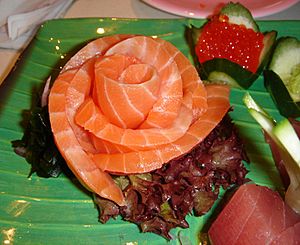
Salmon is a very popular food. It's known as an oily fish and is considered healthy because it's high in protein, omega-3 fatty acids, and vitamin D. Salmon also contains cholesterol.
Wild salmon get their natural orange-red color from pigments called carotenoids. These come from eating krill and other small shellfish.
Most Atlantic salmon sold around the world are raised on farms (about 99%). But most Pacific salmon are caught in the wild (over 80%). Canned salmon in the US is usually wild Pacific salmon. Smoked salmon is also very popular. It can be hot or cold smoked. Lox can be cold-smoked salmon or salmon cured in salty water. Traditional canned salmon often includes some skin and bones, which are harmless and add calcium.
Raw salmon meat can sometimes have tiny worms called Anisakis nematodes, which are marine parasites. Before refrigeration was common, people in Japan did not eat raw salmon. Salmon and salmon roe (eggs) have only recently become popular for making sashimi (raw fish) and sushi.
For the Indigenous peoples of the Pacific Northwest Coast, salmon is a very important part of their diet. For example, the Indigenous peoples of Haida Gwaii in British Columbia rely on salmon as a main food source. Salmon are not just food; they are also important in their culture, art, and ceremonies. The Haida people call salmon "tsiin" and prepare it in many ways, like smoking, baking, frying, and making soup.
Historically, there was always enough salmon because people only took what they needed. However, in recent years, the number of salmon in Haida has been affected. Due to logging and building, much of the salmon's habitat has been destroyed. This has led to limits on how many fish people can catch, which affects families' diets and cultural events. Some salmon rivers that are in danger include the Davidon, Naden, Mamim, and Mathers. It is clear that salmon and their habitats need more protection.
Black bears also depend on salmon for food. The salmon leftovers that bears leave behind are important nutrients for the Canadian forest, including the soil, trees, and plants. In this way, the salmon help feed the forest. In return, the forest provides clean water and safe gravel for salmon to hatch and grow, protecting them from extreme temperatures and water flow.
Images for kids
-
An angler and a gillie (fishing guide) catching a salmon in Scotland.
-
Sockeye salmon laying eggs in Becharof Creek, Becharof Wilderness, Alaska.
-
Scales on The Big Fish sculpture in Belfast, celebrating fish returning to the River Lagan.
See also
 In Spanish: Salmones y truchas para niños
In Spanish: Salmones y truchas para niños


